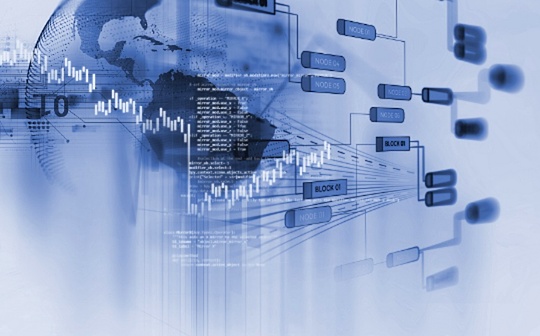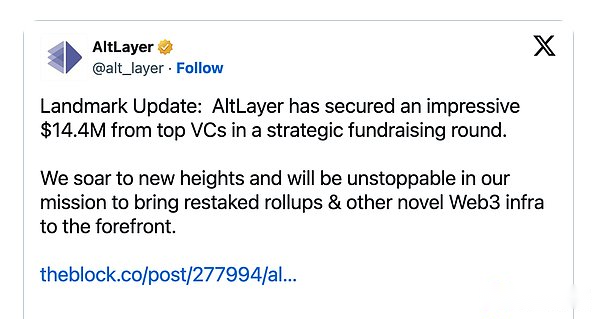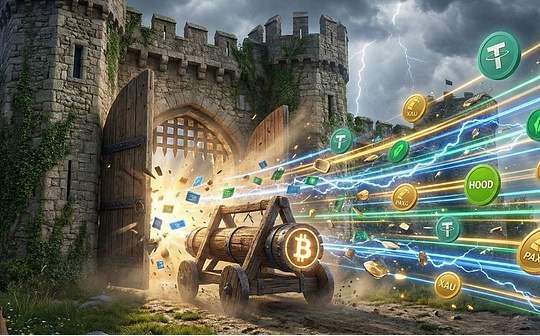
Author: David C, Bankless Translation: Shan Oppa, Bitchain Vision
Another abbreviation has been added to the blockchain vocabulary?
RaaS, i.e. Rollups-as-a-Service.
RaaS is an increasingly popular solution that can meet both customization and scaling needs of blockchain.RaaS is expected to address the complexities and problems faced by rollups today, while making rollups easier to manage and customizable for specific use cases such as DeFi or games.
In this article, we will explore the importance of RaaS, what these platforms can achieve, and which projects are at the forefront of this emerging ecosystem.Let’s get started!
What is RaaS?Why is it important?
Initially, all blockchains were single and operated on only one layer.However, during the bull market, especially the NFT boom on Ethereum in 2021, these blockchains began to experience performance problems as bottlenecks limit throughput and resulted in on-chain transaction fees soaring.
Therefore, modularity came into being.This is a design method that distributes actions across multiple layers to solve these problems.
Rollups embodies this design structure, which will perform separation from the Ethereum mainnet to promote higher transaction throughput while ensuring security and reducing costs.
However, the complexity involved in creating, deploying, and managing these rollups presents challenges, slowing down the rapid adoption of Layer 2 (L2) solutions.The RaaS platform simplifies this process, allowing developers to easily launch rollups even with little coding experience without the usual technical burden.
Therefore, the emergence of RaaS marks a key shift in rollups that is expected to accelerate the adoption of L2.With EIP-4844 released next week – which marks an important step towards its rollup-centric future – and the development of the data availability market as a catalyst for rollups, the rise of RaaS will open up blockchainA new era.This will be an era of interoperability and a time of highly specialized blockchain existence to address any use case.
How RaaS works
The core of the RaaS platform is to provide a range of services to make the process of developing and managing rollups as simple and smooth as possible.These services typically include three types: Software Development Kit (SDK), Codeless Development Options, and Shared Sorter.
-
Software Development Kit (SDK): Provides developers with toolkits to launch rollups, usually configured for specific ecosystems.For example, Optimism’s OP Stack, Arbitrum’s Orbit chain, and zkSync’s Hyperchain.
-
No-code development options: These platforms allow users with limited coding experience to quickly start and manage customized rollups.
-
Shared sorter: These systems work together to process rollup transactions and pass them to Layer 1, such as Ethereum or Cosmos.
Through these services, the RaaS platform provides users, whether developers or non-developers, with the tools they need to start their own rollup.Each RaaS provider customizes development for the three services mentioned above and provides additional features that they find attractive to the deployer.
Below, we’ll highlight some of the leading providers – AltLayer, Conduit, Dymension and Movement Labs – to see the unique improvements they have made on this set.
AltLayer
The recently launched AltLayer provides a common RaaS protocol that supports both optimism and zk summary.AltLayer Considering the future multi-chain, multi-VM (VM) world, it was a smart move to support Ethereum Virtual Machine (EVM) and WebAssembly (WASM) smart contracts (used by Cosmos and Polkadot).Because it allows interoperability across ecosystems and supports future alternative virtual machines such as Solana VM or Move VM.
In their product suite, AltLayer provides a codeless dashboard that allows users without a programming background to launch a large number of custom rollups in minutes, such as specifying a specific number of sorters or gas limits.They also provide the Rollup SDK for developers who want to integrate rollup directly into their products and provide a shared sorter set through their Beacon tier.AltLayer uses a set of basic nodes called the Beacon layer to provide a shared sorter for all L2 rollups deployed through AltLayer.The Beacon layer can also implement cross-chain transactions and messaging between all L2s initiated using AltLayer.

Conduit
The RaaS platform Conduit allows developers to easily launch optimistic rollups, managing all operations, allowing developers to focus on product building.
Conduit initially supported only OP Stack, but later expanded to Orbit chains that support Arbitrum – although the most notable chains they launched all use OP Stack.Zora Network, Public Goods Network, Mode, Aevo, and Frame have all been or will be launched using Conduit.These teams, as well as other teams launched with Conduit, can benefit from their summary for sorter fees and MEV.Some of this costs will also be redistributed to the OP collective to support public goods funding.
To further strengthen its OP Stack chain, Conduit has developed Elector, a consensus layer that reduces the sequencer downtime of OP Stack-based chains by more than 50%.OP Stack traditionally relies on a single sorter, which makes it prone to downtime during software updates or hardware failures, which in turn delays transactions and stops user interaction with the summary.Elector solves this problem by incorporating three sorters into its protocol.If one sorter fails, the other takes over, thus maintaining a “99.95%+” uptime on the summary operation.This innovative approach not only improves reliability, but also allows seamless software and infrastructure updates without any downtime.
Dymension
Dymension is probably the most representative RaaS, a modular Proof of Stake (PoS) blockchain ecosystem tailored for RollApps.RollApps is a dedicated summary designed for transactions that are executed off-chain and managed by a single sorter or a group of sorters.
The architecture of Dymension can be divided into two parts:
-
Dymension Hub: A billing layer that ensures RollApps run smoothly.
-
RollApp Development Kit (RDK): A toolkit for developing and deploying licensed RollApps.
Dymension Hub (Hub for short) is the core and settlement layer of the Dymension network. It works in conjunction with Dymint (Dymension version of the Cosmos Tendermint consensus mechanism) to create blocks for RollApps.Hub checks for updates from RollApps and assumes that they are correct unless otherwise proven, which helps RollApps work faster and less latency.Interestingly, it only generates blocks when needed, saving resources and costs, unlike other chains that generate blocks continuously.Like Cosmos, Hub also connects RollApps, allowing them to communicate, bridge and trade with each other.
In addition, Hub also offers opportunities to pledge Dymension – similar to Celestia’s practice, where people pledge TIA to get other empty investment spaces.Some of the airdrops for DYM stakers that have been announced include ValiDAO (a validator owned by DAO), Avail (modular infrastructure), and NIM Network (a game-centric Rollup).
Dymension
Dymension’s RollApp Development Kit (RDK) is similar to the Cosmos SDK and comes with several modules that accelerate deployment.These modules come from the Cosmos SDK, Cross-Blockchain Communication (IBC) protocol, Ethermint and CosmWasm, which work together to provide RollApps with tools such as governance, token transfer, upgrade capabilities, and support for EVM and CosmWasm smart contracts.
Additionally, Dymension RollApps stands out for a range of benefits gained from Hub, such as inheriting the same level of security as the billing layer, or being able to use Dymension’s validator network instead of booting its own – which greatly reduces the security budget of the chainAnd minimize token dilutions, as they do not have to incentivize validators to participate when they are first launched.Additionally, by outsourcing consensus to Hub, RollApps can focus on maximizing throughput and reducing latency.More importantly, thanks to Dymension Hub’s native automated market makers (AMMs), they can share liquidity – address common problems with L2 (liquidity fragmentation) – and can charge for payments in any token of their choice.Fees, not Dymension charges fees.To initiate adoption, Dymension recently launched an incentive program for its AMMs, distributing over 100% APR to liquidity providers in certain pools.
Gelato Network
Last September, Gelato, the leader of Ethereum chain backend infrastructure and smart contract service providers, announced the addition of Rollups-as-a-Service to its suite.Gelato supports OP Stack, Arbitrum Orbits, and Polygon Chain Development Kit (CDK), making it easy for developers to launch optimistic and zero-knowledge (ZK) rollups using their favorite frameworks.Additionally, Gelato’s background as an infrastructure provider allows them to provide developers with additional tool suites, such as:
-
Account Abstract: A software development toolkit that allows developers to build more user-friendly wallets with features like “Login with Google,” “Register with Email” or Gas-free transactions.
-
Web3 features: Services that allow developers to connect smart contracts to off-chain data and automatically perform responses.
In addition, their vast network of infrastructure partners allows developers to further enhance the functionality of their chains through cross-chain integration or convenient fiat deposits and withdrawals.
Gelato’s existing product suite and partner ecosystem provide a solid foundation for it to compete with other RaaS providers.The suite allows them to further cater to the developer experience while allowing developers to focus on building the best user experience with tools – whether it’s using account abstractions or fiat deposits and withdrawals.
in conclusion
The RaaS (Rollups-as-a-Service) platform provides a series of tools to help developers build a modular blockchain future.
RaaS platforms like AltLayer, Conduit, Dymension, and Gelato Network can not only mitigate rollups by providing a range of services such as SDKs for developers, codeless options for non-programmers, and shared sorter systems for efficiency improvementsCommon complexities can also lead the future where blockchain can become a customized, highly interoperable and can be developed by almost anyone.
As the blockchain field continues to develop, it will be interesting to see in which areas will RaaS gain a foothold (if it can really gain a foothold).Regardless, RaaS offers an exciting opportunity to solve the common problems that plague L2 while bringing together various ecosystems so that all can enjoy its fascinating qualities.








